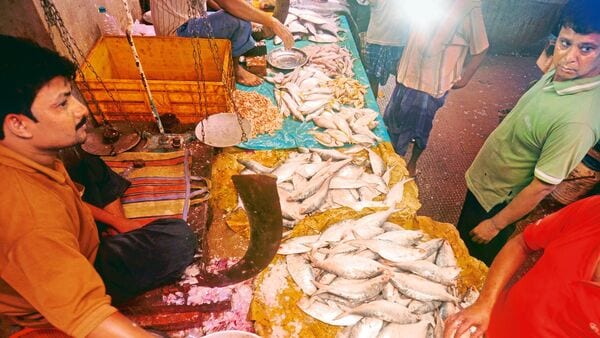 News
News
Love Hilsa? Get ready to pay more this year

Summary
- Hilsa production has fallen in India, while Bangladesh has reduced the quantity available for exports, and shrunken the window for shipments. Result: Higher prices in India at a time of high demand during Durga Puja.
For lovers of Hilsa shelling out more for their favourite fish this year, the worse may be yet to come as a shortened import window draws to a close, at a time of falling catch and reduced imports.
After a short-lived ban, supplies from Bangladesh have resumed at a lower pace, raising prices that are already high. In Kolkata's wholesale fish markets, Padma ilish, or Hilsa from its Padma river, a Hilsa fish of 1.5 kg now costs ₹2,000-2,200, up ₹600 from last year. In the retail market, prices are ₹100-150 more.
While daily Hilsa arrivals in two key markets in Delhi's C.R. Park are down to one quintal against the 3-4 quintal in previous years, in Kolkata, each shop gets only 5 kg, down from 20 kg earlier, traders told Mint.
A key reason is the falling catch over the years.
“There has been a substantial decline in production over the past decade, which fuels price rise. If you consider from the 1980s till now, the decline is more than 70%, and it is likely to remain stagnant for the next 5-7 years," said B.K. Das, director, Central Inland Fisheries Research Institute (CIFRI). Torrential rains at a time Hilsa migrate from the sea to the rivers have affected production, Das added.
Hilsa production in India this year could be about 4,000 tonnes against last year’s 5000 tonnes, Das said. Hilsa is not bred artificially, since it swims upstream from the sea to freshwater for spawning and returns afterwards.
Also read | Three decades on, Hilsa returns to the Ganga
Bangladesh accounts for more than three-quarters of the world's Hilsa catch, followed by Myanmar (15%), and India (4%). Connoisseurs consider Bangladesh's Padma Ilish tastier than its Indian counterpart from West Bengal's Hooghly.
Das said unlike Bangladesh which keeps vigil on fishing and enforces fishing bans and rules on fish size, fisherfolk in India do not always follow rules, depleting the fish population. Besides, Bangladesh has larger Sundarbans backwaters area compared to India, he said.
Another reason is this year's shorter window for imports (26 September-12 October) against the usual 1 September to 31 October, and the lower quantity on offer. Prices eased a tad after Bangladesh lifted the ban, but the window will close soon.
In 2012, Bangladesh banned Hilsa exports; however, since 2019, a few thousand tonnes are allowed to be exported to India during Durga Puja as a goodwill gesture.
“As soon as the import window closes, ilish prices are expected to go up by ₹400-500 a kg for the 1kg and above size, unless landing of ilish from sea to river water increases in India," said Syed Anwar Maqsood, secretary of Fish Importer’s Association and Howrah Wholesale Fish Market.
Maqsood said India has received about 250 tonnes since Bangladesh allowed exports of about 2,420 tonnes on 26 September. He does not see India being able to import more than 500 tonnes this year compared to last year’s 587 tonnes of 3,950 tonnes allowed, which may push prices up in the domestic market.
Devraj Roy, a fish seller at Delhi's C.R. Park said prices may go up by ₹150-200 a kg for fish of 1-1.25 kg due to the demand surge during Durga Puja, and may remain firm for one and a half months. “Once the Ilish price go up, it never comes down."
“Ilish is a cultural thing for us. It is something that all Bengalis like to have on their plate frequently, but due to high prices this year, we could only have Ilish twice in three months, which wasn’t the case previous years," said Anirban Mukherjee, senior project manager at Brillio and a resident of New Town in Kolkata. “The first time when I bought Ilish was in August when our daughter visited us, and I paid about ₹2,500 a kg for the entire 1.2 kg size Ilish. We had it again when the Bangladesh variety arrived, over the last weekend. This time, I bought a 1-kg size for ₹1,800," he said.
Also read | Can Berger Paints sustain market share, margins amid growing competition?
“I thought of buying Ilish after going to the market but after knowing the price quotation, I had to drop the plan given its soaring price this season. However, we managed to get the 700-750 gm sized Ilish twice in three months and four times since mid-April," said Saibal Mukherjee, senior manager-R&D of Berger paints India Ltd and a resident of Kakurgachi who shops from Kolkata's Manicktala market.
Queries sent to the spokespersons of Bangladesh High Commission in New Delhi, spokespeople and secretaries of union fisheries department, external affairs and commerce ministries remained unanswered at press time.

